Physical Address
304 North Cardinal St.
Dorchester Center, MA 02124
The incidence of pediatric back pain increases with age and has a prevalence of nearly 40% by 18 years of age. While back pain is often related to overuse in sports, work, or a specific traumatic event, it may also be idiopathic, infectious, inflammatory, neoplastic, or secondary to anatomic lesions. While back pain may be mild and resolve spontaneously in athletically active adolescents, back pain in younger children is more unusual and may suggest significant disease (tumor, infection). Persistent back pain in children necessitates a thorough evaluation to rule out disorders that can result in significant morbidity, such as infection or tumor. Back pain is not a disease but a symptom and is often associated in adolescents with headaches, emotional problems, daytime tiredness, and behavioral disorders. Activity modification and rehabilitation or exercises for the spine may help reduce risk for recurrent episodes. Severe or persistent back pain necessitates a thorough history, physical examination, and appropriate imaging studies to evaluate the child for potentially serious pathologic processes.
The back is often defined as the area from the first thoracic vertebra to the top of the sacrum. The spinal column is composed of vertebral bodies that articulate with each other through intervertebral disks. Each vertebral body has a posterior arch, which includes the spinal and transverse processes, as well as the articulation of the superior and inferior facets.
Vertebral growth occurs in an orderly manner throughout childhood and adolescence. About 50% of vertebral column height is present by the age of 2 years. Each vertebral body contains superior and inferior growth plates, which typically ossify at approximately 4 years of age and close in late adolescence. Acceleration of vertebral growth occurs during the adolescent growth spurt but contributes less to total height than does lower limb growth; the sitting heights of siblings in early and late adolescence are often remarkably similar. Spinal growth slows at menarche in girls and at the time of voice change in boys and is usually complete 2–3 years later. Developmental abnormalities of the column, such as idiopathic scoliosis, most commonly first appear just before the growth spurt. Alterations in spinal configuration caused by congenital deformities of vertebral segments change most rapidly during periods of rapid spinal growth: before the age of 2 years and at the time of the adolescent growth spurt.
There is a strong association of genitourinary, neurologic, gastrointestinal, and dermatologic system abnormalities in patients with congenital abnormalities of the spine. Warning signs of more systemic pathology in patients with congenital spine deformities include leg length inequality, foot size asymmetry, high foot arches, hairy patches or hemangiomas or a mass over the spine, sacral dimpling, enuresis, toe-walking, asymmetry or abnormality in the lower extremity deep tendon reflexes, and lower extremity weakness.
The normal trunk is symmetric when viewed from the front or the back ( Fig. 46.1 ). The shoulders and pelvis are parallel to each other and to the ground. The distance between the right and left elbows and the sides of the trunk is equal. When the trunk is viewed from the side, a series of curves is present (see Fig. 46.1 ). A convex anterior lordotic curve is present in the cervical region. The thoracic spine is concave anteriorly in a kyphotic pattern. The normal lumbar spine is lordotic, and the sacrum and coccygeal regions are kyphotic. Normal adult sagittal alignment develops gradually; children younger than 10 years typically have less cervical lordosis and more lumbar lordosis than adults. Injuries, infections, tumors, inflammation, and developmental abnormalities of the spine often produce alterations in these expected contours. Range of motion is demonstrated in Fig. 46.2 .
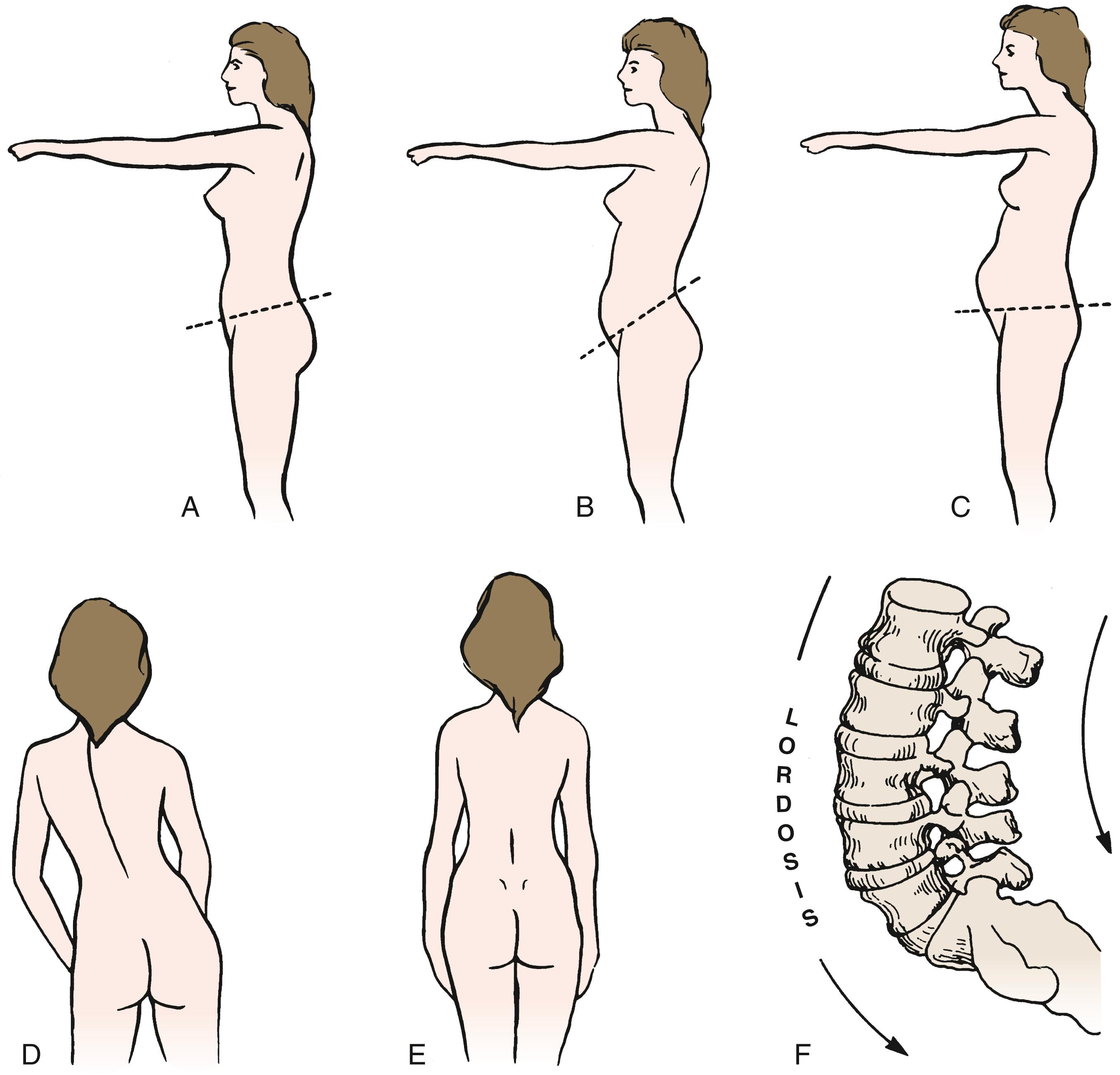
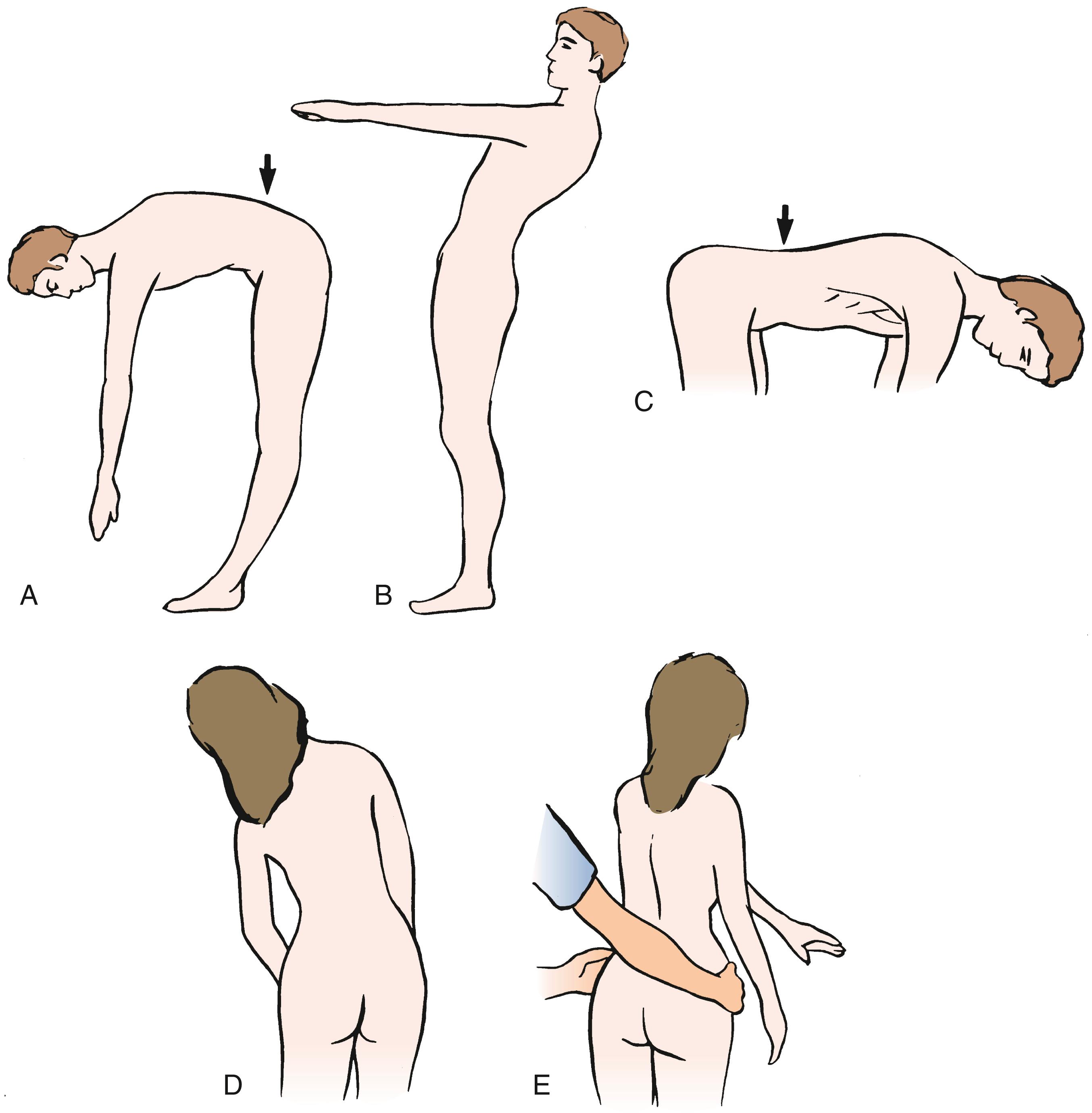
Examination of the spine should be part of the routine physical examination in the healthy child and adolescent. Patients presenting with a chief complaint of back pain require a detailed history and thorough physical examination ( Table 46.1 ).
| History |
|
| Physical Examination |
| General Appearance and Palpation |
|
| Motion |
|
| Lower Extremities |
|
When findings on screening examinations are abnormal or when a patient presents with complaints of back pain, a more detailed examination is required. The spinal vertebral column, spinal cord, and spinal nerves are intimately related, and disorders affecting any of these elements may produce symptoms and signs in the others. Detailed examination of strength in the muscles of the spine and lower extremities ( Fig. 46.3 ), sensation ( Fig. 46.4 ), abdominal and lower extremity reflexes, anal sphincter tone, and perianal sensation should be performed when the primary examination suggests involvement of the neural structures that pass through the spinal column.
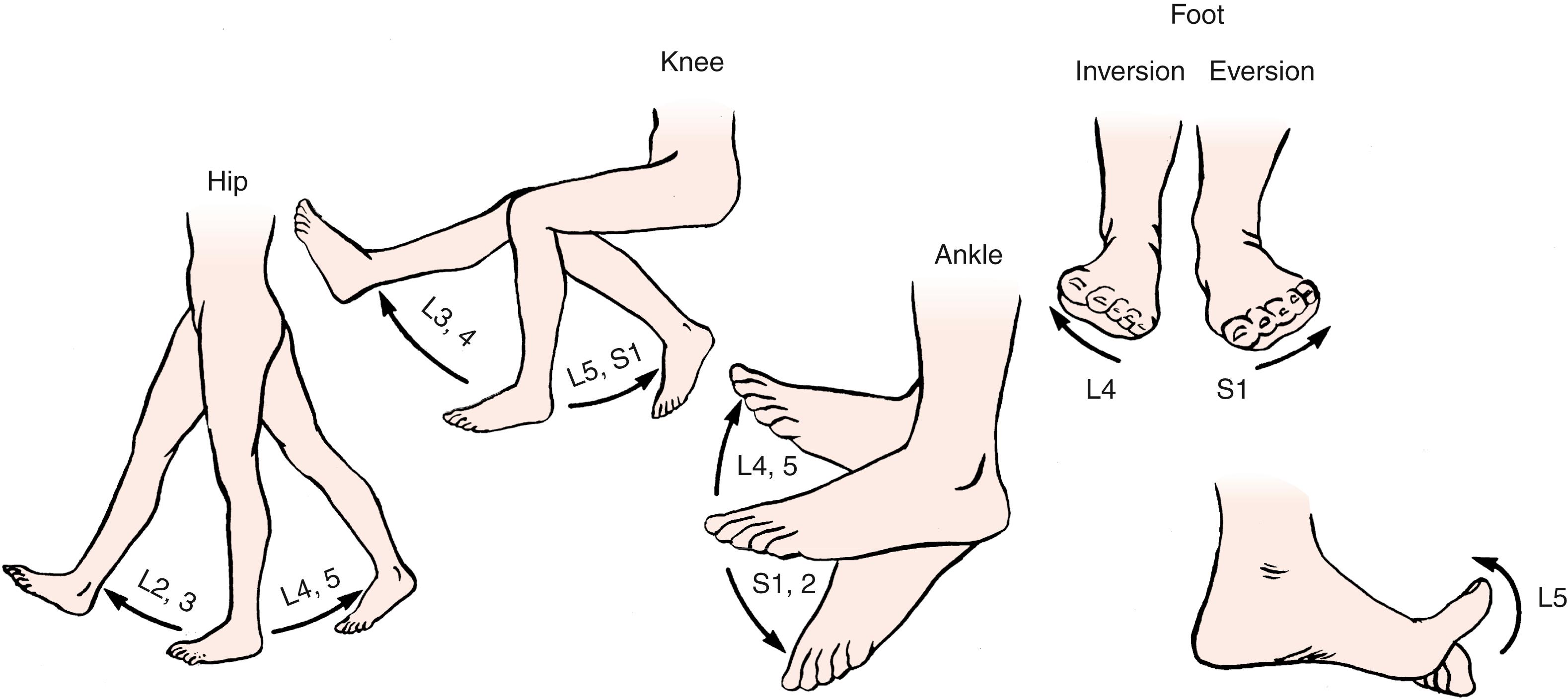
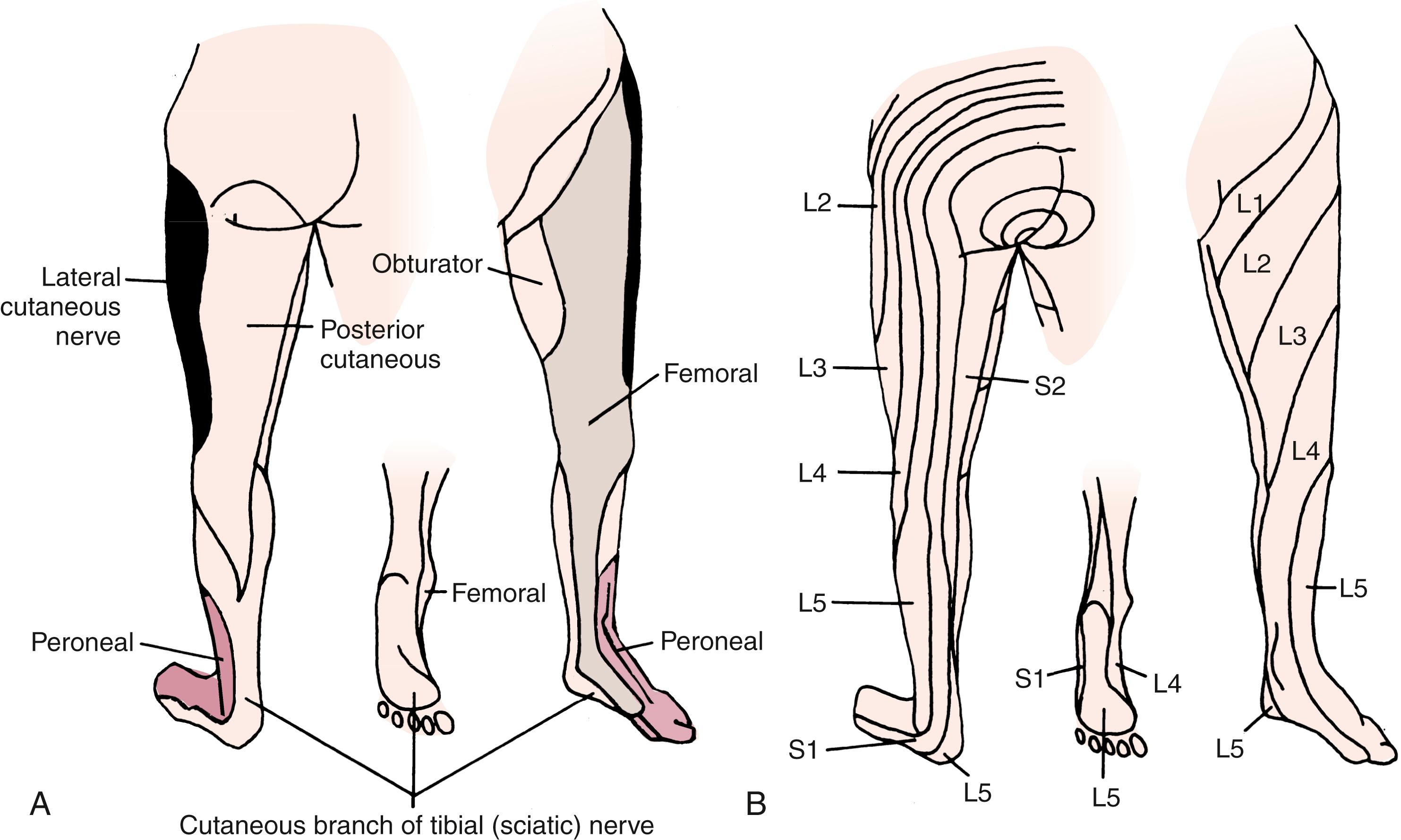
In children younger than 10 years of age, extremity injuries are more common than back pain related to routine play and organized sports activities. When the trunk is involved, contusions and abrasions are much more common than ligament sprains and muscle strains.
When a child presents with back pain of brief duration after a play- or sports-related injury, a careful examination should be performed. If there are no other associated injuries and the screening examination shows no alterations in trunk configuration or lower extremity strength or sensation (see Figs. 46.3 and 46.4 ), no further work-up is necessary. A brief period of rest for 1–2 days, followed by gradual resumption of activities, is appropriate treatment. Imaging studies are not necessary when the duration of symptoms is short and the physical examination findings are normal. Signs of systemic illness (fever, weight loss) or neurologic deficits warrant an immediate, more in-depth evaluation.
Acute back injuries occur more frequently in adolescence, as the sizes of participants and potential forces generated in recreational activities increase. If there are no other associated injuries and the screening examination findings are normal, no further imaging work-up is necessary. A brief period of rest followed by gradual resumption of activities remains appropriate treatment. The importance of a comprehensive and balanced conditioning exercise program should be stressed to young athletes. Sport-related injuries can be reduced by preparticipation conditioning, appropriate warm-up, careful supervision, and resting when fatigued.
Trauma sufficient to cause acute spine fractures may occur because of motor vehicle or bicycle crashes, falls, and diving and gymnastic injuries. The frequency and severity of spine trauma rises in later adolescence as exposure to these events increases. In such cases, there is a clear relationship between the trauma and the onset of symptoms. Injury to the spinal column should be suspected in all individuals whose level of consciousness is impaired after a crash or sports injury, regardless of the presence or absence of symptoms.
Children with suspected acute spinal injury should be immobilized on backboards designed for children until definitive imaging studies can be performed and interpreted. Immobilization of the child’s cervical spine on a solid backboard should be avoided. The child’s occiput projects farther posteriorly than an adult’s, causing cervical flexion if the child’s neck is immobilized on a standard backboard. Spinal immobilization boards for children are readily available and have a cut-out section to accommodate the occiput. When such boards are not available, a blanket or firm mattress should be interposed between the trunk and the backboard to prevent neck flexion.
Persistent or severe back pain is uncommon in young children but is more common in athletically active adolescents. Mechanical low back pain is said to be present in the patient with no definable pathology on physical exam or imaging studies, but frequent exam findings include tight hamstrings, poor posture, weak core musculature, and discomfort with paraspinal muscle palpation. This is the situation in over 50% of patients presenting with low back pain. The implications of severe or persistent back pain are more serious in younger patients than in adolescents. Persistent back pain in young children is usually not the result of a congenital spinal deformity or developmental disorders of the spine but may be due to infection or tumor. As a child enters and passes through the adolescent growth spurt, back pain may arise from a small number of congenital and developmental disorders of the spinal column. Degenerative disorders of the spine such as intervertebral disk herniation are uncommon causes of back pain in childhood. In evaluating a patient, it is important to try to distinguish musculoskeletal-mechanical disorders from those with more generalized systemic signs or those suggestive of a neoplasia ( Fig. 46.5 ). Concerns for neoplastic or infectious etiologies herald the need for advanced imaging; if the MRI shows no definitive pathology, then patients are considered to have mechanical low back pain. Pediatric multidisciplinary pain clinics also help those who have persistent pain that is not responding to usual treatment.
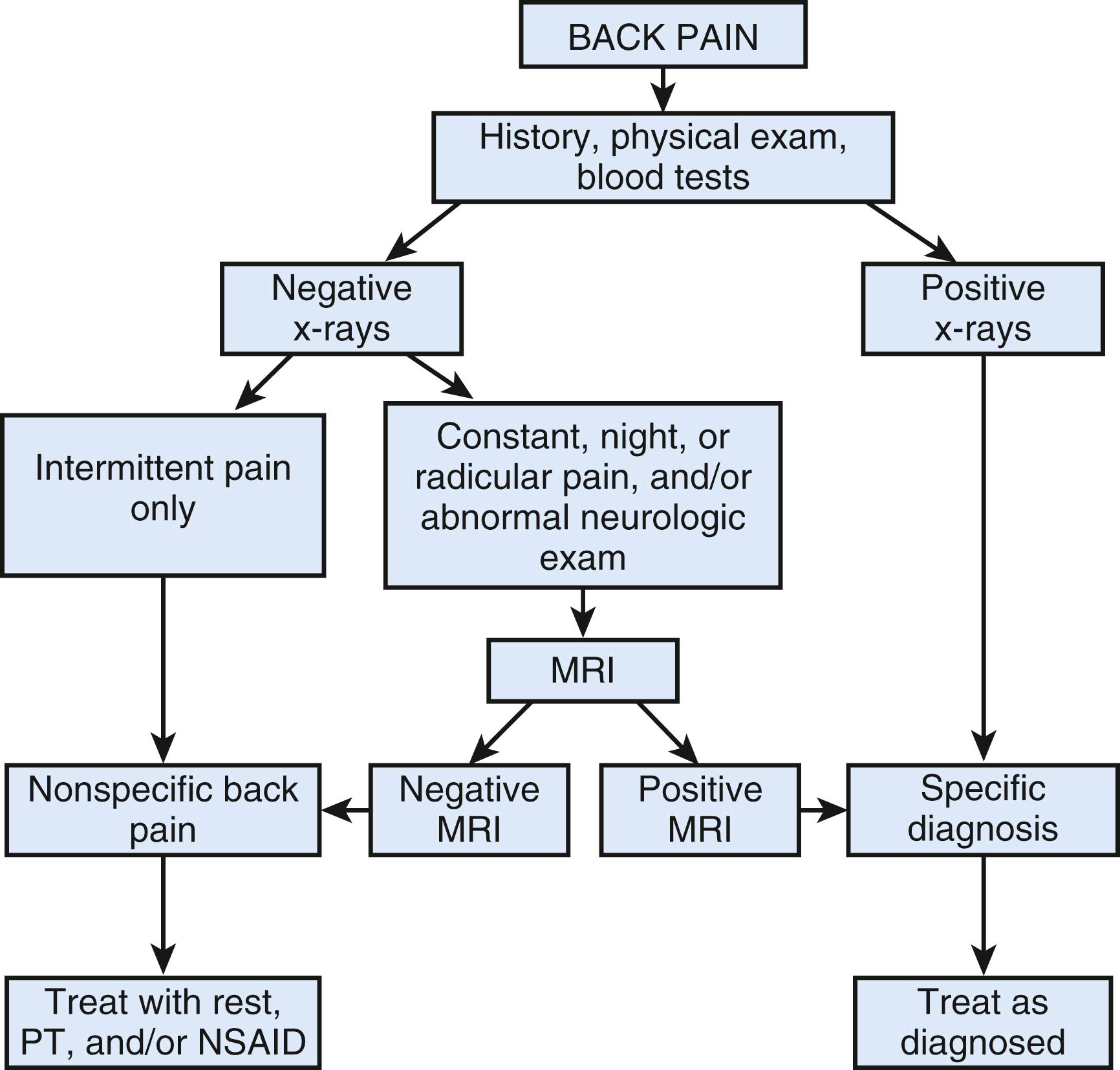
The differential diagnosis for pediatric back pain varies with age. In neonates and infants, infection, neoplasm, and nonaccidental trauma should be considered. As patients age, it becomes easier to obtain a history and physical exam. In children younger than 10 years, there is still heightened concern for both bone and hematologic neoplasm (osteoblastoma, leukemia, lymphoma). Infectious disorders like spondylodiskitis (diskitis and osteomyelitis) tend to be more localized. At this time, rheumatologic disorders may begin to appear. In older children and adolescents, infectious, neoplastic, and rheumatologic disorders should remain in the differential diagnosis list. Congenital and developmental variations in the formation of the spine may cause back pain. Most commonly, the period of rapid growth and increase in physical activity and athletics results in a greater frequency of musculoskeletal injuries (strains, stress fractures, disk pathology) .
| Inflammatory and Infectious Diseases |
|
| Rheumatologic Diseases |
|
| Developmental Diseases |
| Mechanical Trauma and Abnormalities |
|
| Neoplastic Diseases |
|
| Other |
|
Diskitis and vertebral osteomyelitis represent a single bacterial infectious process involving both the disk space and the adjacent vertebral bodies ( Fig. 46.6 ). Spondylodiskitis is most common in toddlers and in early adolescence. Diskitis may begin as a microabscess within the vertebral body adjacent to the vertebral end plate. The disk becomes infected from perforating vascular channels across the end plate. Vascular channels may also perforate the end plate on the opposite side of the disk, leading to involvement of the opposite vertebral body.
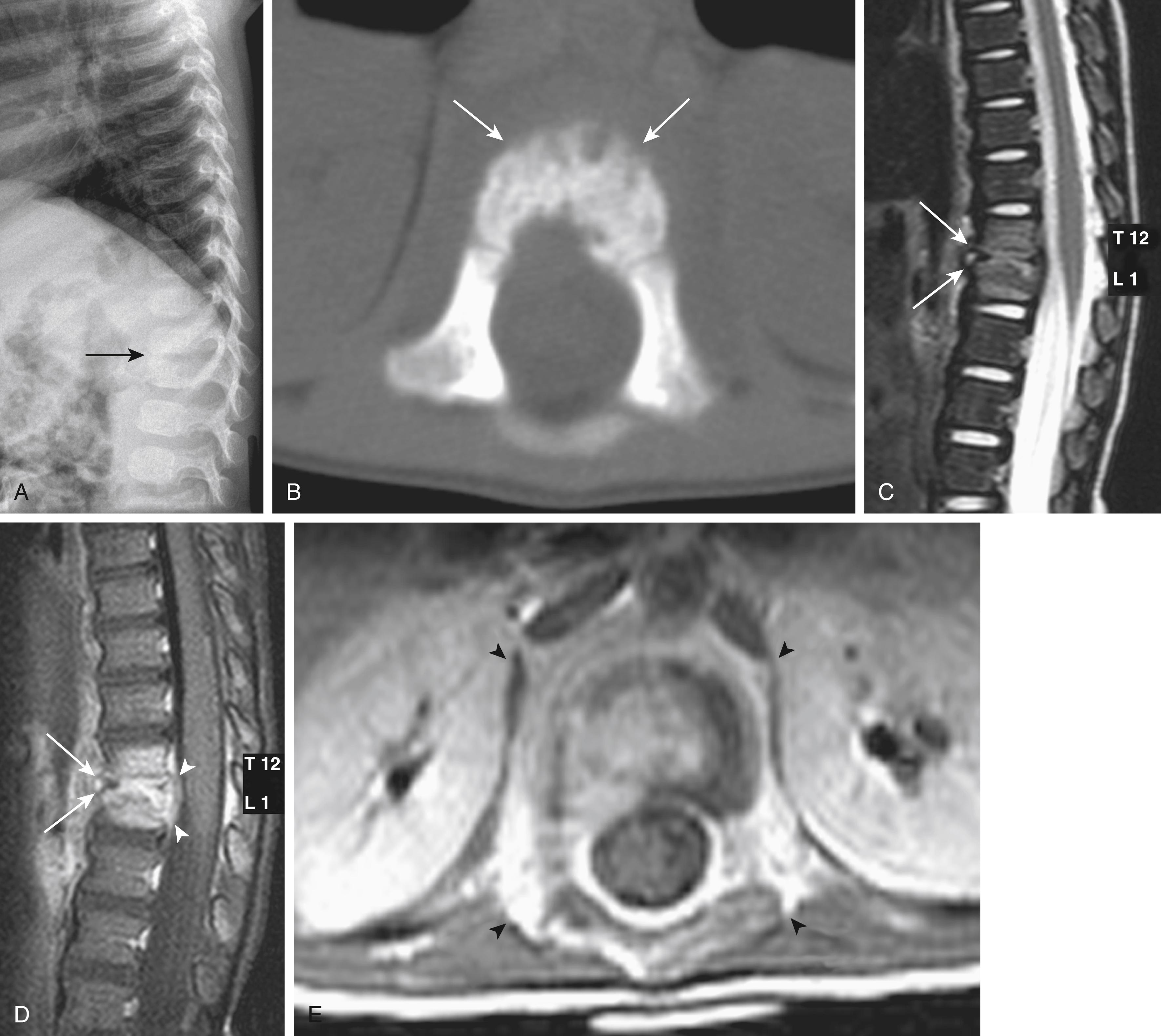
Most commonly, diskitis is a bacterial infection, usually caused by Staphylococcus aureus . Other pathogens include Kingella and Brucella organisms. Mycobacterium tuberculosis should be considered in patients who have spent significant time outside the United States, in patients who have recently immigrated, or in high-risk, immunocompromised patients ( Fig. 46.7 ).
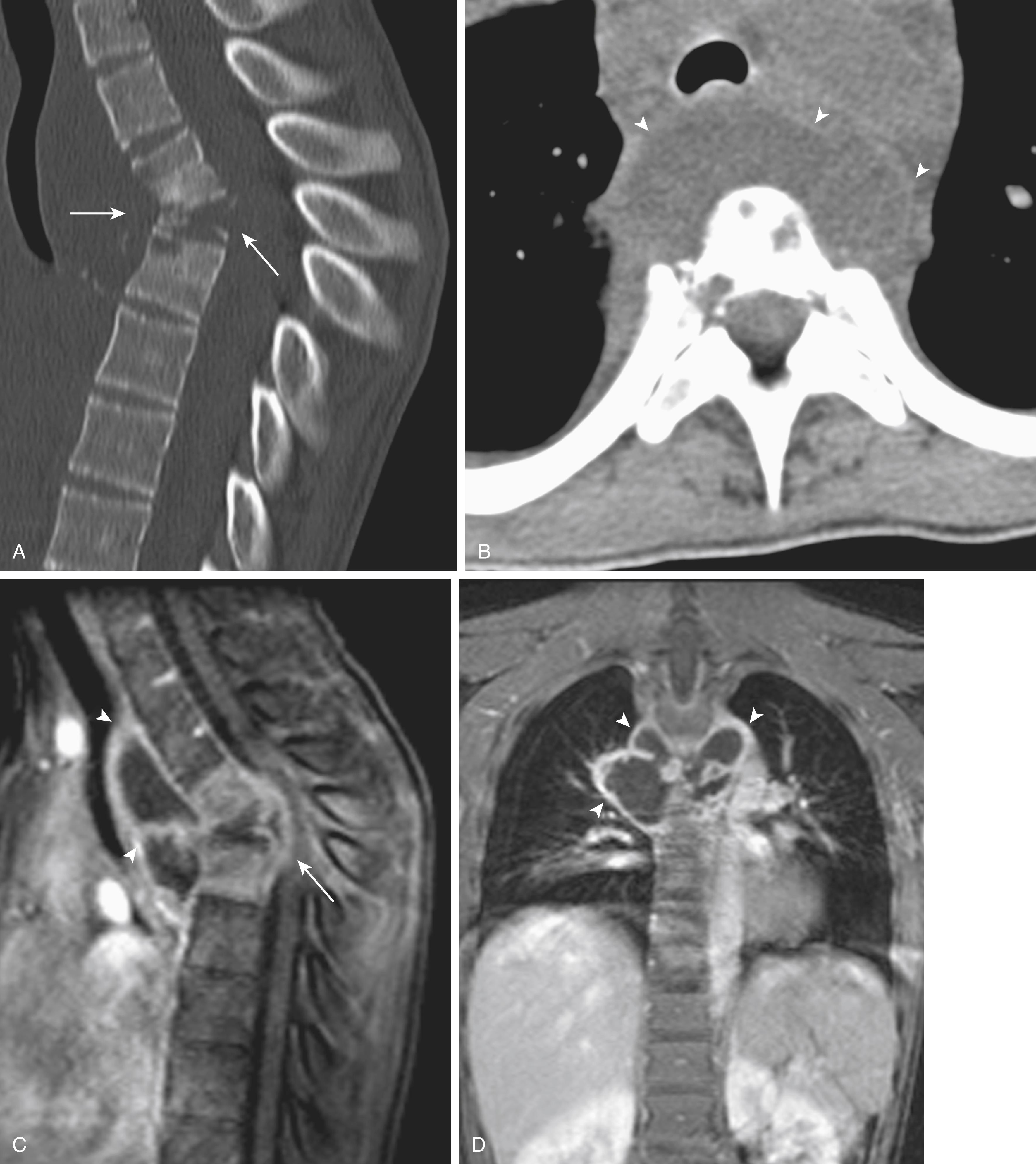
Three age-dependent patterns of presentation have been noted for spondylodiskitis. Children younger than 3 years (the most common age) often present with irritability and refusal to walk and sit, and may have apparent dysfunction (limp, antalgic gait) of the lower extremities. Patients may have loss of lumbar lordosis (the lumbar spine is the most common site) and refusal to allow passive motion of the lumbar spine. Patients between the ages of 3 and 8 years often have pain referred to the abdomen, particularly when the disk involves the lower thoracic spine. Preteens and adolescents (next most common age) with diskitis often have back pain; the discomfort often radiates into both legs. Additional features at all ages include fever in ∼50%; refusal to bear weight (sitting or standing); refusal to bend forward; and, if intraspinal inflammation is present, decreased lower extremity muscle tone and strength, and alterations of deep tendon reflexes. Both S. aureus and tuberculosis may also involve adjacent paravertebral soft tissue abscesses (psoas, iliopsoas muscles).
Radiographs of the spine in nontuberculosis disease may be normal early in the disease. Over about 3 to 4 weeks, radiographs may reveal disk space narrowing with subsequent erosion and sclerosis of the vertebral end plates. Radiographic findings often lag behind clinical presentation with diskitis. MRI is the definitive imaging study (see Figs. 46.6 and 46.7 ). The MRI reveals the extent of the inflammatory process better and can delineate the degree of bone destruction (if any), the presence of paravertebral or epidural abscess formation, or intraspinal inflammation. Tuberculous spondylodiskitis ( Pott disease ) often has multiple levels of vertebral involvement as well as noncontiguous lesions, while bacterial spondylodiskitis usually involves one disk space and the adjacent vertebral bodies. CBC is normal in ∼50%; however, the ESR is elevated in >90%. Blood culture should be obtained as well, but this is also usually negative. If positive, a blood culture can help identify appropriate antibiotic treatment.
The diagnosis of bacterial spondylodiskitis should be suspected in patients with fever and unexplained back or leg pain and in previously healthy toddlers who become irritable and refuse to walk. Spinal cord and vertebral tumors are major considerations in the differential diagnosis, which can usually be diagnosed with MRI. After appropriate laboratory studies, including blood cultures, have been performed, treatment should be started. In patients with a positive blood culture, targeted antibiotic therapy should be started. Patients with negative blood cultures should begin broad-spectrum antibiotics, ensuring coverage of S. aureus . Consultation with pediatric infectious disease specialists may be helpful. Initial therapy should be intravenous; oral antibiotics can be considered as pain decreases and laboratory studies return to normal. A total of 4–6 weeks of therapy is recommended for patients with bacterial spondylodiskitis. Pain control and immobilization of the spine may be helpful in reducing symptoms.
Patients who remain ill or worsen (or those with epidural or paraspinal abscesses) after the initiation of antibiotic treatment should undergo surgical biopsy and drainage. Biopsy should also be performed in patients in whom tuberculous intervertebral disk space infection is suspected (positive exposure history, positive purified protein derivative, pulmonary lesions, or positive QuantiFERON results).
Radiographic changes continue long after the inflammatory process has resolved. Progressive disk space narrowing, intervertebral disk space calcification, and spontaneous intervertebral arthrodesis are potential late findings.
The most common cause of low back pain in the adolescent (particularly those active in athletic activity) is spondylolysis. This is a fracture at the pars interarticularis, or the junction between the superior and inferior facet in the posterior arch of the vertebral body. The prevalence of spondylolysis has been reported in up to 8% of the population and nearly 50% of adolescent athletes with low back pain. The frequency is increasing in younger children due to the dramatic rise in year-round training for youth sports. In 80% the spondylolysis is bilateral; some develop spondylolisthesis, a deformity where the superior vertebral body translates or slips anteriorly on the vertebral body beneath it ( Figs. 46.8, 46.9, and 46.10 ).

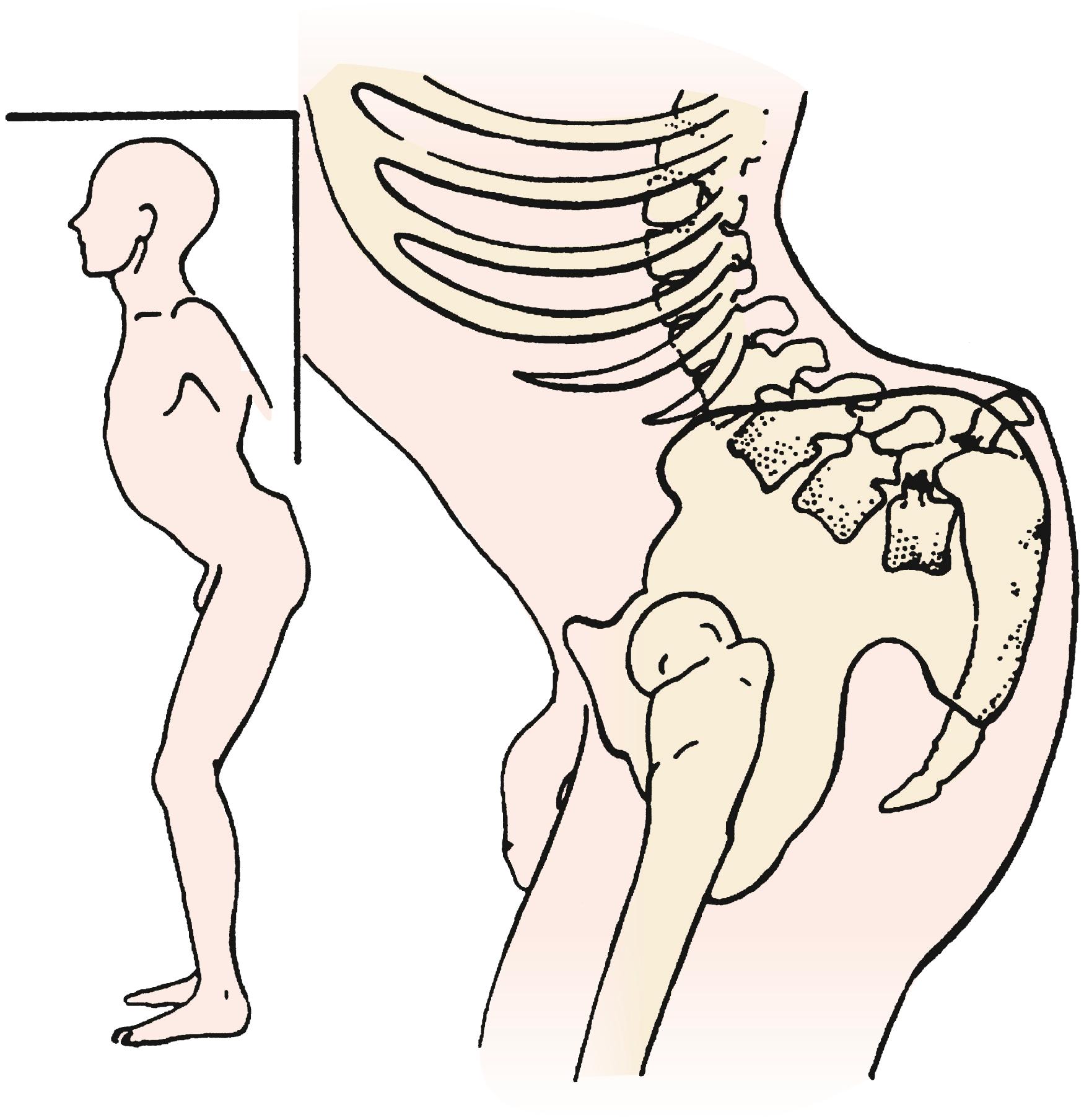

Spondylolysis and spondylolisthesis in children and adolescents usually involve the fifth lumbar and first sacral units. Less commonly, spondylolysis and spondylolisthesis can occur at L4, L3, and L2. Spondylolysis appears to be less common in Black persons and much more common in some North American Eskimo groups; the lowest incidence has been reported in Black females, and the highest in White males. The male-to-female ratio is 2:1. The disorder appears to be multifactorial; both hereditary and mechanical factors have been implicated.
Spondylolysis can be secondary to underlying dysplasia of the posterior spine. It is not present at birth, but with growth and activity, it is seen by age 6 years in about 4% of children and 6% of adults. A high rate of spondylolysis has been reported in Scheuermann disease (thoracic kyphosis), which may be related to compensatory excessive lumbar lordosis. In addition, an increased incidence of spondylolisthesis has been noted among both patients with neural tube defects and those with cerebral palsy. It can also result from acute trauma, although fracture/dislocation of the spine from violent trauma are other causes.
Most commonly, spondylolysis is secondary to repeated stress from activity and sport, especially sports that require repetitive trunk flexion and extension like gymnastics, dance, and football linemen, but can occur in any sport. These forces cause stress or fatigue fracture of the posterior elements of L5 and may be responsible for acutely painful spondylolysis in some preadolescent and adolescent athletes.
Become a Clinical Tree membership for Full access and enjoy Unlimited articles
If you are a member. Log in here